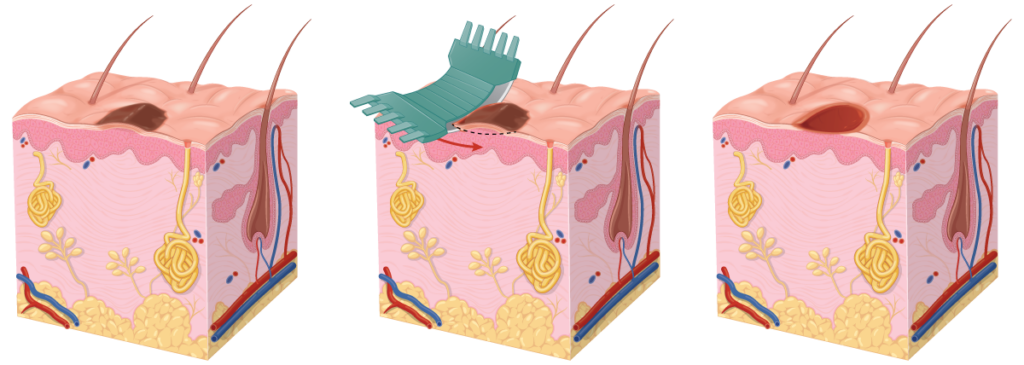They are primarily used for superficial lesions or lesions that essentially sit on the skin (exophytic). The procedure is normally quick and simple. Variations of shaves are referred to as saucerisation or tangential excision.
There are different procedural intents for a shave, which will influence how it is performed:
- To obtain tissue to confirm a diagnosis (biopsy).
- To debulk the lesion because it is painful, annoying, or obstructing vision or functionality. It may be done for short-term relief while awaiting more definitive surgery.
- Sometimes we need to debulk a lesion to assess the extent of it.
- To improve the cosmetic appearance – either to remove a (benign) lesion or to take it down flat with the skin surface.
Shaves are commonly performed for seborrhoeic keratoses (Seb Ks). Occasionally shaves are performed to diagnose a melanoma. It is important to note that a shave excision is not the first-line recommendation for taking a biopsy for melanomas – it requires care to ensure an adequate sample is obtained.
If a very superficial shave is performed there is a low (but not zero) risk of scarring. However, there is still a risk of pigment changes. Deeper shaves will cause a depressed scar.
A key limitation of shave procedures is that because it takes a superficial sample of tissue an assessment of invasive disease or lesion depth can not be undertaken. Nonetheless, it is still a useful procedure in certain contexts.

The shave excision procedure
- Local anaesthetic will be administered prior to the procedure.
- A tangential shave excision of the skin is normally taken with a specific shave instrument. Sometimes, they may be taken with alternative instruments including a scalpel blade.
- This will normally create a superficial wound similar to a graze.
- The wound will be cleaned and a dressing applied. White soft paraffin may be used to minimise scab formation and to improve the cosmetic outcome.
- The sample may be sent to the laboratory for histological analysis.
- You will be provided with a written information sheet that includes our after-hours contact number. While we don’t expect problems, we want to ensure that we are there for you should the unexpected arise.
Post-procedure
After the procedure, there will be a superficial graze or ulcer of the skin. The wound will gradually crust and heal over several days. There are no stitches to be removed from the wound and as a result, you can normally continue your regular activities with minimal change. However, ideally, you would keep the wound clean and dry for the first 1-2 days.
About 2-3 days after the procedure, you can normally remove the dressing. We will supply you with white soft paraffin and we encourage you to apply this a few times per day to help minimise the amount of crust formation which will help to optimise the cosmetic outcome.
As with any surgical procedure, in principle, there is a risk of infection and bleeding. However, with a shave these risks are low. Because shaves are superficial in nature, there is a risk that the lesion recurs – although this will depend on the type of lesion that is being treated.

